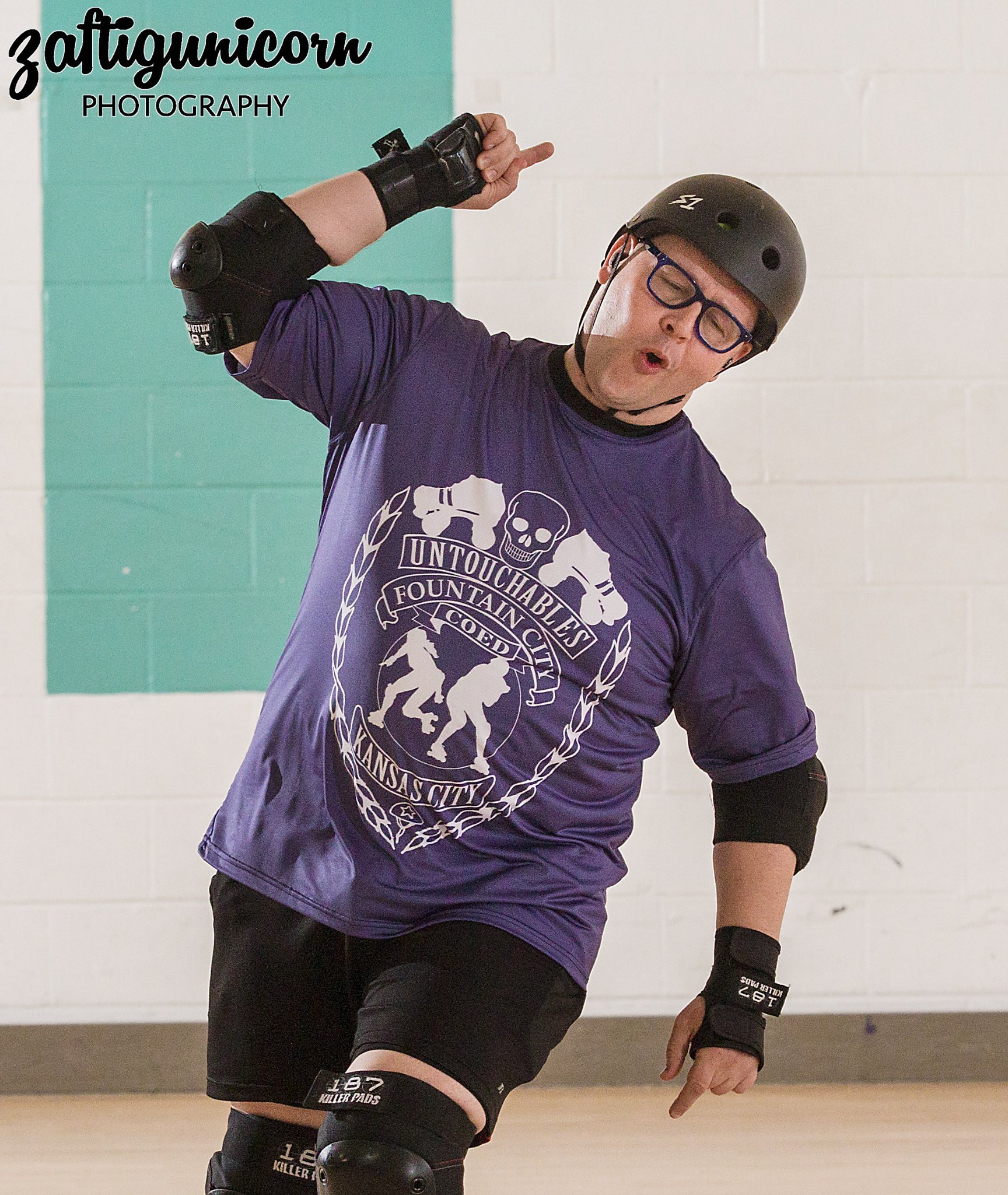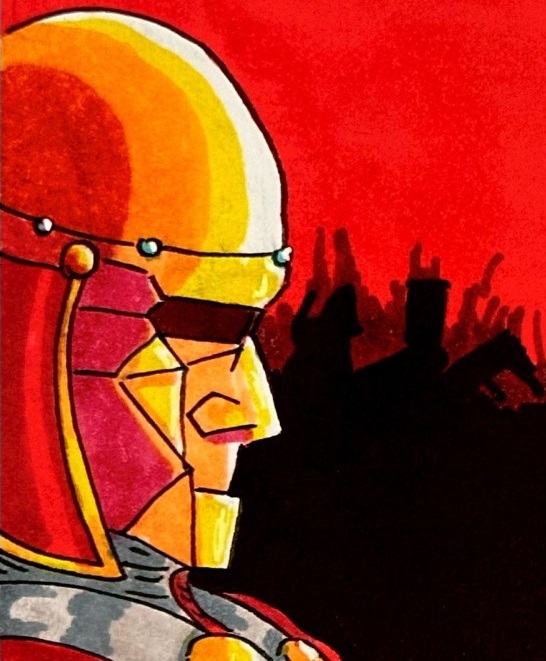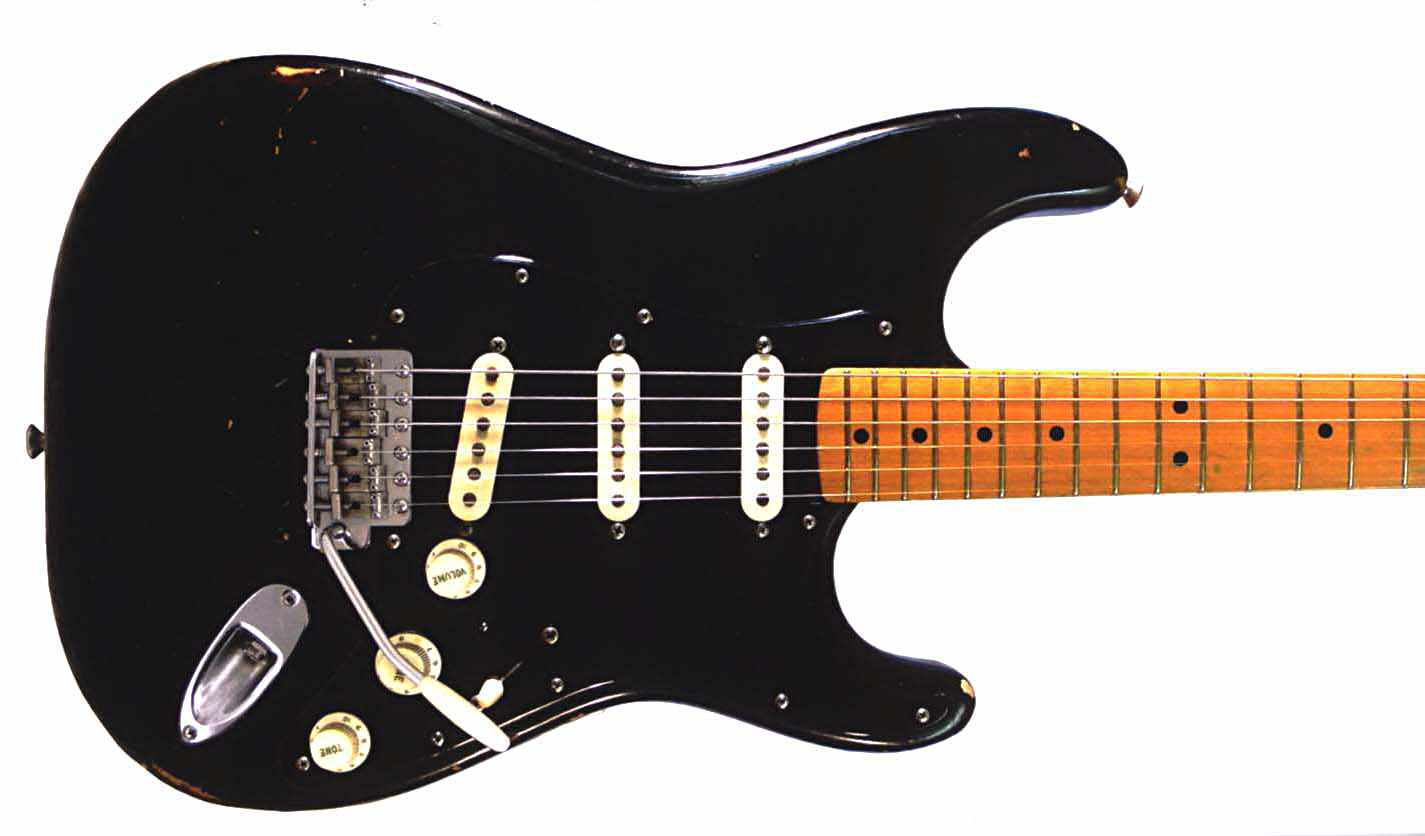My two are:
Making sourdough. I personally always heard like this weird almost mysticism around making it. But I bought a $7 starter from a bakery store, and using just stuff in my kitchen and cheap bread flour I’ve been eating fresh sourdough every day and been super happy with it. Some loafs aren’t super consistent because I don’t have like temperature controlled box or anything. But they’ve all been tasty.
Drawing. I’m by no means an artist, but I always felt like people who were good at drawing were like on a different level. But I buckled down and every day for a month I tried drawing my favorite anime character following an online guide. So just 30 minutes every day. The first one was so bad I almost gave up, but I was in love with the last one and made me realize that like… yeah it really is just practice. Years and years of it to be good at drawing things consistently, quickly, and a variety of things. But I had fun and got something I enjoyed much faster than I expected. So if you want to learn to draw, I would recommend just trying to draw something you really like following a guide and just try it once a day until you are happy with the result.
“Easy” being relative… 3d printing. Especially with modern printers. Leather working is easier than i thought although i won’t say I’m awesome at it. Probably the easiest thing i’ve learned is homebrewing. 90% is cleaning. Outside of that if you can boil water you can brew. Extract kits make it super easy. From there you can go all grain or stick ti extracts. Or if you want super easy, go mead. Honey, water, yeast. That’s it.
Hypnosis. Pretty much 100% of what the average person thinks about how hypnosis works is wrong: there’s no mysticism, no magnetism, no magic, no Freud, no “clash of willpower”, no “permanent side effects”, no “mind control”, no risk of “never coming back”.
You simply have to put a convincing act that you, the hypnotist, have “the power”, and nearly everything you say will work. You play with people’s expectations. There’s no “recipe” for a surefire way to hypnotize someone, because it doesn’t “work” with everyone and even on the people it works, it’s not the same experience.
Ironically, I have difficulty being hypnotized myself, which sucks. Or maybe I have too high expectations of how I should feel while being hypnotized.
To get good at being hypnotized practice guided meditation. It’s the same thing, but guided meditation is often easier as it tends to exclusively be aiming at getting you into trance and taking you out.
Fantastic trick for getting young kids to sleep - at least, until they get freaked out that someone has the power to induce sleep and fight the technique. Which, in hindsight, fair I guess.
Tried passing on the trick from a self-hypnosis perspective after that point but it just didn’t take. Interesting stuff though - makes me wonder if I should look into hypnosis from a hobbyist perspective again.
Edit: Of course, there was also the time I did it with my then girlfriend to induce an a super vivid but otherwise undefined imaginary scene, and butted right against some repressed trauma I was not equipped to handle, aside from lots of hugs and "You’re ok"s. Soooo… this is what I get for hypnotizing people armed only with the experience of being hypnotized once, a self-hypnosis book I played around with as a teen, and a pretty detailed scene from an underground fiction novel, I suppose.
Reading
Thanks to e-books and the Libby app you don’t even have to physically go anywhere or pay anything to find a good book these days.
I’m a slow reader and get frustrated with how long books take. My “internal” reading speed is about as fast as reading aloud, so anything longer than a few hundred pages takes forever.
Im the same with reading speed. You could try finding a block of time you would otherwise just be on your phone so it feels less an jnvestment (e.g. before bed, riding the bus, or break at work). I use e-books so i don’t have to remember it and opening the book is as easy as social media. Finding something you WANT to read is hard too.
If you’re into fantasy then branron sanderson is great. The Way of Kings grabbed me after getiing past the prologue (bonus points for women written decently). Alternatively Name of The Wind by patrick rothfuss. If only he’d finish the trilogy…
If only he’d finish the trilogy
Lol, never gonna happen. And he (Rothfuss) certainly doesn’t write good female characters. (Lookin’ at you, unnecessary author self-insert with the sex fairy bang sesh)
If interested, you might look into “sub-vocalization”. I mention it because you state your reading speed is close to your talking speed; possibly you are making miniscule movements with your larynx and surrounding muscles as if you were talking, without actually talking, and that limits your reading speed to talking speed.
People who get into speed reading often work on sub-vocalization suppression or interference techniques so that it isn’t a speed limiter.
Or you may just process written words at that speed. Everyone’s different.
Interesting. I’ve actually noticed myself doing that, and just assumed it was something everyone did. I’ll definitely be looking into it. Thank you!
A lot of people do do it. And it’s not necessarily a bad thing in all cases. Like when intentionally reading slower, trying to commit something to memory, sub-vocalization is helpful.
That can happen. My focus is weird, and I strongly zone-in to what I’m doing, so for me reading is a very engaging and fun thing to do.
Try audiobooks.
I listen to them while doing chores like the dishes or folding laundry. If you get distracted, just repeat the last few minutes.
Audiobooks are not a replacement for actual reading. It’s still nice to have, but your brain fires off different synapses. They are nice to have in the car.
Don’t be such a book snob. I was answering to a person who has a hard time reading. Between making life harder on yourself, not reading or listening to audiobooks, the latter are a good alternative.
Read how you personally want (as do I), but don’t judge others for their reading or not reading habits.
Also Anna’s Archive!
libby is such a game changer. i totally get why a lot of people want to only read physical books but for me, being able to read anywhere at any time instead of having to make a concious decision to find and bring a book with you means i read way way more than i used to
For me it’s that I have to think less about my choices. I don’t have a ton of time anymore so if I pick a book I am not vibing with I can just return it and pick another in a matter of seconds. It’s led me to taking chances on books I normally wouldn’t read.
Oh yeah!
I have a 75-page rule. If a book hasn’t grabbed me by then, I move on.
I’m a mix of both. I generally read a book for the first time on Libby and then end up buying a physical copy for my home library.
I like physical books in a theoretical sense. Some hardcovers are beautiful and it’s hard to resist the urge to collect them.
But I don’t really like reading physical books. I really don’t like the typesetting of 70-80 characters on a page. That leaves a lot of my books at maybe 2-3 paragraphs per page, and it’s really hard to get into a flow that way. On an ereader I can control the layout, the font, and really get into a book.
(And that’s on top of the fact that I can carry thousands of books around with me, borrow from the library, and take notes more effectively for nonfiction.)
What font/layout settings do you prefer that get you really into it?
I use roboto. I especially like how Moon+ reader renders it with antialiasing. Font size depends on the screen and reading distance, but the end result is generally 50-100% more per page. I don’t feel like I’m spending all my time turning pages that way.
I still use PDFs for stuff with graphics, diagrams, code, etc. I don’t think epub maintains the formatting well enough. But if a book is mostly prose, I find the ability to reflow the text helps me a lot.
And the too much detail follow up lol.
full page

That’s roboto size 13 on a boox go color 7, on moon+ reader.
macro
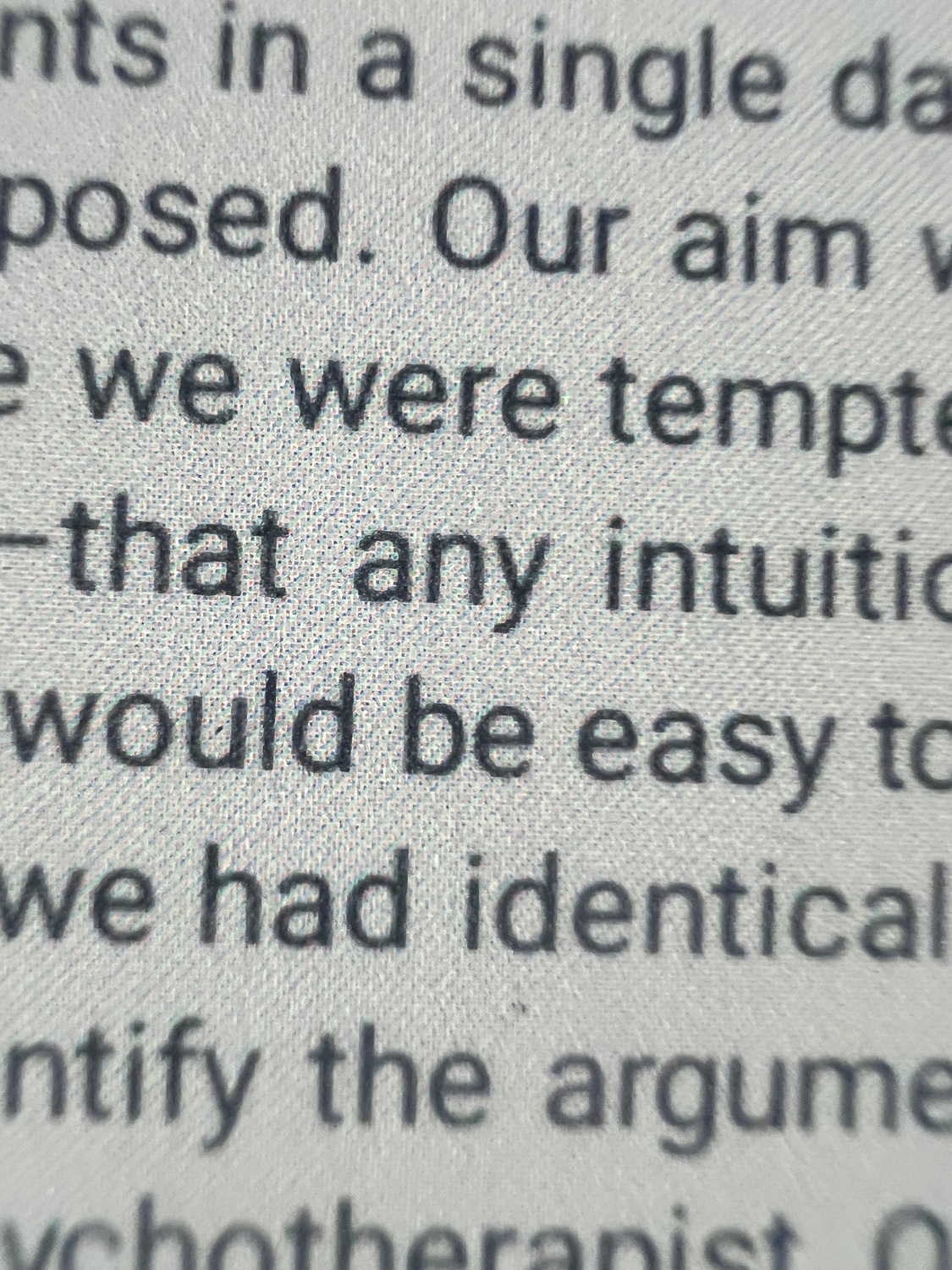
And a macro shot of the text to show that the apparent sloppiness is really just the picture. But other apps without the smoothing don’t always look the same. I’ve used different variations of the font on different apps to get the best result.
The actual hardcover
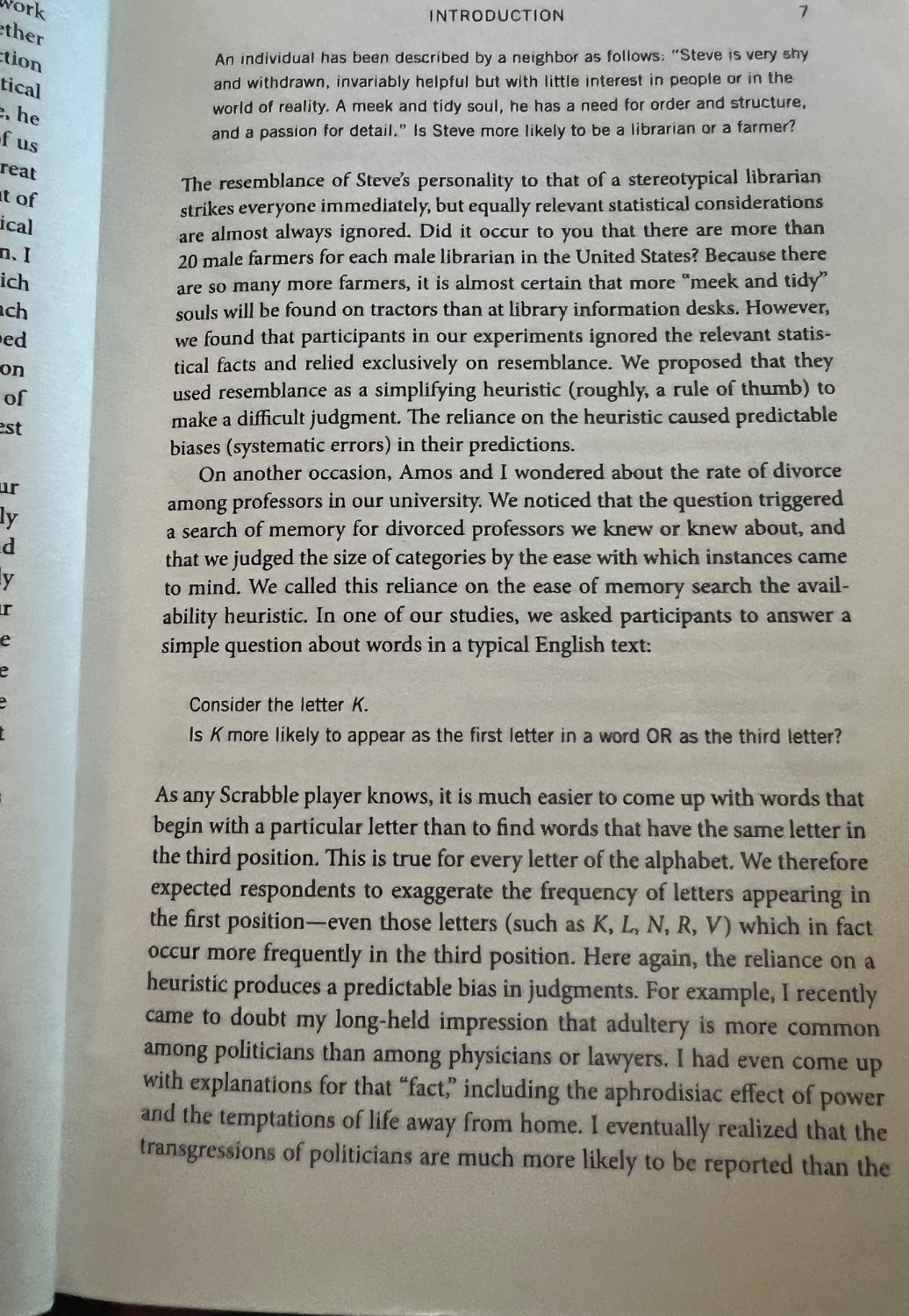
Doom scrolling
Has anyone found a way to get out of this hobby? Asking for a friend.
The answer will surprise you!
Switching my phone screen to black and white actually does help, but the temptation to switch back is powerful.
For an honest answer: someone else on lemmy once said they just scroll down on the homepage and let it free-scroll for a while, then stop and work back up. When they get to the top they leave lemmy and move on with their day.
Maybe you’ll find an answer if you keep scrolling down…
Have my angry upvote.
I’m back. Still nothing.
Heck, even some clients have auto scroll, really really easy this hobby.
Playing older video games via emulation. The barrier to entry gets easier and easier as time marches on. And as long as you have disc space to download the games, you’ll likely find a repository somewhere on the Internet.
Oh yeah some even let you play in browser now. Crazy how it takes seconds, and most peoples phones can even play most everything game cube and earlier.
That is a particularly handy feature for older computer games from DOS and C64.
You can also play at the Internet Arcade or Classic PC Games on archive.org.
Anbernic handheld consoles are awesome and inexpensive.
I recommend the RG35XXSP. It’s shaped like a Gameboy Advance SP and plays lots of Dreamcast & N64 games plus everything below that.
$60 + Shipping Directly from Anbernic
or
$90 with free 1 or 2 day shipping from Amazon
I’ve been playing tons of GameCube games since Dolphin recently released RetroAchievement support. (Basically community made achievements for retro games, available for tons of games and consoles)
Chinese handhelds (sbcgamings) are an interesting rabbit hole.
Modding my Vita blew my mind.
Miyoo Mini Plus!!!
My childhood dream.
And if you don’t flash drives/micro SD cards are dirt cheap and stupid fast these days. May as well be external storage in an easy to loose stick or microSD card.
I’ve never had a problem playing my collection of old games I used to own externally.
Painting miniatures. Anyone can do it and make their board games look way nicer.
All you have to do is avoid paying New-In-Box GW prices, and avoid/minimize GW paints and the cost of the hobby drops through the floor.
Tons of skirmish games in all settings are around, many of them with free rules. Battletech is cheap because it basically needs skirmish game amounts of minis. Even playing 40k is cheap(er) embracing third party and scratchbuilding.
Can you recommend good paints to get? I’m interested in getting into model making but all the options are kind of overwhelming and reviews are all over the place.
90% of my paints are Vallejo Model Color. Good value for the price, never had any quality control issues.
Vallejo Game Color is their newer line where they’ve focused on brighter and more saturated colors for the 40k audience. Same company and quality.
I supplement my Vallejo Model Colors with some Duncan Two Thin Coats paints when I want super saturated colors. This line also has pretty decent metallics which I now use, since I can’t find Vallejo Mecha Color anymore.
I do still use Citadel Nuln Oil and Agrax. I have the old formula bottles, and I don’t use wash that often or much, so it will be a while until I buy new ones.
A few random products from Tamiya, MIG, and AK. All are speciality things like rust effect washes. Not really needed for starting out.
I also have a collection of cheap Applebarrel paint from WalMart. These are great for painting bases, doing low importance areas of vehicles, painting terrain, and being drybrush paints for vehicles. Much more cost effective than using hobby paints for this purpose.
I managed to sidestep Games Workshop pretty neatly. I’m huge on Battletech and pretty much exclusively use Army Painter paints. I also have a lot of board games like Scythe or Betrayal that have plain gray minis that I’m working on.
Blender. Not great at it, but there’s so many fantastic tutorials on YouTube. I can use it good enough to design and 3d print simple things. Of course, there’s may aspects / layers to it. It’s both broad and deep. So it’s good to kind of focus on one thing at the time, and then break that down even further.
Man, I tried to get into this. Spent months running through the tutorials. I just couldn’t grasp how they design flow of creating a complex shape from scratch. It just didn’t “make sense”.
I’ve found parametric modeling programs like Solidworks far, far more intuitive to use - it’s easier for me to grasp “okay, this thing is a combination of added shapes, extrusions, negative spaces, revolved outlines, etc” than what Blender wants you to do. Unfortunately, most parametric programs really don’t offer good skinning/texturing and only mediocre rendering options.
Blender tends to work better for organic shapes. I know because I suffer a LOT to make more parametric stuff with it. I really should learn how to properly use something like Solidworks, Fusion360 or something along those lines.
Try onshape. I learnt fusion last year though YT and playing around for 3D prints.
Its fine but a bit of overkill. Onshape has just enough support that a search for “how to do X” takes you to the wiki or official forum, and boom. Answer.
It also seems more initiative and just gets out of the way, compared to fusion.
No idea if its just coz I learnt fusion first though.
I tried solid works but nothing clicled for me with that.
I hear you on that. On the reverse, trying to make “smoothly flowing” curved shapes in Solidworks is a headache (similarly, I’ve suffered trying). They do offer a slicing tool so you can import your monkey head from Blender and convert it into parametric object(s).
I totally get that. It’s like finding a programming language or personal information manager app that you like. Have to try a bunch out to find something that works for you.
A long time ago I dabbled in script-generated ray tracing. That was fun, but I never got great at it.
I also learned PostScript for a while, because I wanted to create some very intricate printable forms. Using WYSIWG tools was just not cutting it. I ended up with some large 300dpi forms that I liked, whuch were perfect for the assignment.
Sometimes a different model or approach can make a huge difference to your work flow.
What are your favorite tutorials about Blender specifically for 3D printing? Any channel recommendations?
I do resin printing. All models get sliced into 2d layers by the slicer program. Therefore, the geometry of the mesh isn’t nearly as important as it would be for something you wanted to animate or use in a game. (Pro 3d modelers take great pains to keep their meshes very clean and smooth, made up of all triangles, etc. But if you’re just going to convert the thing to a bunch of 2d slices, you don’t need that level of discipline.)
You can basically overlap and tweak a bunch of primitive shapes (cubes, spheres, cylinders, etc) to build a complex shape for the thing you want. Then you can export that as an STL file and load it into your slicer. Once inside the slicer you can add any needed supports and then slice it.
In order to get to this pretty basic level of competence, I just watched several tutorial videos on the basics. Like how to add shapes, scale them, modify them, mirror them for perfect symmetry, etc. I have watched some videos on texturing, lighting, etc. out of curiosity but you don’t need any of that for resin printing.
And once you export it as an STL it looks like one solid thing, so it’s easy to rotate it around and so on in the slicer program.
“Blender Guru” is a really well done Blender tutorial channel, but he also covers a lot of things I don’t really need. Early on, I learned a lot from the “tutor4u” channel.
Wholeheartedly agree! Nomad Sculpt ^(yo-ho!) via tablet & stylus is a great addition to this notion, and makes for far better modulation in post than creating in zBrush (multiple parts v. inseparable object).
What sort of resin printing do you do, and what part of the world, if you don’t mind me asking?
I have an Anycubic 4k resin printer. I’m in the US. Most of the time I am printing miniatures for tabletop gaming using STL files I find online. However, sometimes I want to customize them. And more than once I’ve needed to repair some broken household object and needed to print a part for it. I’ve also made a few original gifts for people from scratch. I’m not a very good sculptor, but I can make funny / cute things and put their name on it, stuff like that. I can also copy stuff pretty well if I have enough photos of it from enough 90-degree angles. It’s a very fun hobby, I wish I had more time for it!
Oh, for sure. I feel ya there. Some days, I almost wish it was still just a hobby for me, heh. But, the hours are decent, and I absolutely love the creative aspect as well as the personalized service of most prints I make for others. I certainly had no idea that the “Satanic” pastimes I was up to in the early days would somehow build into a bonafide job, that’s for sure. 🤣🤓
You actually succeeded in the quest from hobbies to career. Well done!
Thank you :)
As someone who also prints with resin, let me tell you that a decent mesh is crucial for bigger pieces that you need to make hollow. More often than not, objects are an amalgamation of smaller things cobbled together, but without vertices connecting them. When you try to hollow such a piece, it won’t work “the right way”, so you can end up with hollowed pieces that have no holes and will leak, break or fail somehow after fully printed.
Years ago, I also had to deal with an object that had some 50k loose vertices, invisible to the naked eye because they didn’t make any edges or faces, but chitubox sliced as if it had a million faces covering the entire build plate.
Another thing I do, mostly to help with stopping chitubox from crashing, is reducing the face count of models (Modifiers -> Decimate). Yes, 4 million faces, lots of detail, etc etc, but if it’s a 32-40mm tall mini, it’s extremely unlikely you’ll notice any differences between that original and a version with ~600k faces, both printed together.
Thank you for adding this to the discussion. I should have specified that I only print smaller things, maybe 10cm tall at the most. Most things I print are much shorter than that. I have only printed one hollowed print (out of hundreds of objects). For my modest needs, the savings on resin is usually not worth the hassle of cleaning / curing the interior cavities. I can definitely see how having bad geometry could foul up a large, complex and/or hollowed print!
I mostly print miniatures as well, but sometimes it’s miniature vehicles, or other sorts of big miniatures that, if hollowed out, can drop from ~35g to ~15g of resin needed. When a typical 36mm tall mini will usually take 5g with supports, that’s a big difference.
I remember I gave up printing a chibi Duran (from Trials of Mana), roughly 8cm tall, because each piece of the hair was a separate object, thus impossible to hollow “as is”. The hair alone was probably more than half of the total resin needed for the piece.
I’ve been wanting to learn blender for the same reason. Complicated models are an absolutely bitch to work with in parasolid modeling engines.
However, for simple designs, parasolid modeling is spectacular for designing models for printing. Fusion360 has a free tier for hobbyists (they hide it and you have to go hunting to find it, but it exists), and I’ve done most of my designs there.
I’ve also used tinkercad for really simple edits. I’ve heard great things about solidworks, but it’s expensive af, even for a hobbyist account.
Not sure exactly what you consider ‘expensive’, but there are ways to get a student edition Solidworks account for $100/year. I consider that a pretty reasonable price.
Personally, I find it infinitely more usable than Blender, but that may just be my personal biases in play. Your mileage may vary.
That’s absolutely reasonable, but I’m not a student. Is that required by the license agreement?
Making chainmail. All you need are a decent pair of flat pliers and some rings. A basic 4 in 1 weave is super easy to learn. There’s more complex stuff of course, but starting out is ridiculously simple. I made a dice bag with probably a dollar or two worth of galvanized steel rings, leather string, and a plastic drawstring clasp.
This would never have crossed my mind as a thing to do. What else does a person make besides a shirt / armor?
Beanies? Cast iron pan scrubbers? Novelty blankets?
Novelty blankets?
I’ve heard of people who made chainmail blankets not as a novelty but as essentially a weighted blanket for when it’s warm. I don’t know how well it would work in practice because I’d imagine it’d pinch hairs all over you body pretty often but it still seemed like a pretty neat idea.
If you sleep in pyjamas or have a thin sheet between you and the chainmail, then perhaps the hair pinching would be less of an issue.
Haha, personally I’ve made dice bags and nifty bracelets. Chainmail bikinis are also a thing that’s more popular than you’d think.
The chainmail creators for tge Lord of the Rings movies made so much chainmail that they were their fingerprints completely off.
making mead:
honey, yeast, water, shake the carboy, pop on the airlock (fancy cork), wait two weeks.
wine making:
juice, sugar, yeast, water, shake the carboy, pop on the airlock, wait two weeks.
No camden tablets for sterilization?
I’ve never found them necessary.
I use a baking soda/water combo to clean out carboys between uses, and ill dip the airlock stopper in boiling water before attaching it, any cloth i use to wipe things down is boiled beforehand.
as long as everything is clean before the carboy is sealed, you’re good.
I’ve never lost a batch.
knock on wood.
Whittling
Just buy a knife kit and some wood blanks, surprisingly affordable.
And, it only takes a few trips to the ER to find out how shite you are at it! Win! Time for another hobby that requires only a few fingers! 🤩🤌🏽
Yeah I should have added the cut proof gloves and thumb protectors
The bizarre culture (pun intended) around sourdough is maddening. The obsession over the “ear,” bannetons, lames, daily feeding: all bro club bullshit. This is the bread humans have been making for millennia; the only tools you need are one hot rock and one not-hot rock.
Do you even sour, bro?
Lul reminds me of the coffee bros. With their 3.4 sec at 666 degrees vs 8.9 sec at 69 degrees pour or whatever they call it.
It’s the exact same phenomenon. Surely astroturf bullshit started by whomever is selling the useless tools.
That and I think there’s a fair bit of eliticism as well. Everyone is always trying to one up each other and since you can only go so expensive with the beans and equipment the next step is to be pretencious with the prep.
elitism* pretentious* 🙃
Thanks bud, I be struggling here.
There are some serious differences between a badly made loaf and a well done one though. You never stop learning. But yeah, it’s easy to get something passable.
None of the differences have anything to do with the Bro Method.
Combat Sports.
I got bored of the gym, so I decided to take BJJ. Grappling is really fucking hard, as in you have no clue what you’re doing, and no idea how to stop someone from fucking you up on the ground. It’s one of those sports that you can spend six months doing and barely get a feel of wtf is going on.
Two years later, I was somewhat capable, and got my blue belt. I then noticed that I was actually pretty good compared to the white belts. Things started to make sense, and while I got absolutely fucked up by everyone else, the positions made sense. I’m now a purple belt, and the other day I did an iminari roll and a rolling guillotine on a white belt during a spar, just because I could.
In the middle of this, I started doing MMA. Striking is also hard, especially when you mix with wrestling/grappling. I came in as the guy that was fucking useless with striking, but when we took 45 mins to do some grappling the coach was wondering why the new thirty-something idiot was tapping everyone. Eventually we found my level, and he gave me some solid pointers on how to work on my striking to bring it up to level with my grappling.
All in all, combat sports seem pretty scary, but getting into it is just a matter of turning up and giving it a try. You’ll feel like a useless idiot for months, but before you know it people will be asking you wtf you just did to them…right after you had had the same conversation with the person that’s better than you.
Photography. Cost of a used high quality DSLR + batteries + storage cards + cheap tripod = $500-ish. Lessons = free thanks to piracy and YouTube.
Its so much fun! I buy used SLR cameras and equipment from estate sales on the cheap (always below $30) and develop my film at home instead of paying $10 a roll to have it processed in a lab (chemicals cost $24 for 24 rolls of developing ) about to start bulk rolling my film for the cost of $6 a roll as opposed to spending $10-$16 per roll from the photography shop near me. Brining the cost down to shoot and develop the film from $26 per roll to $7 per roll.
Then in a few years you’ll be gassing for those 3k lenses a 5k camera and a carbon fibre tripod, a few flashguns etc.
I’ve been in it for 10 years now and I largely use the same gear. My camera is 16 years old and my lens is about 12 years old. I use a Neewer tripod and sometimes swap lenses with someone I know who has a nice 70-200 mm.
Last year I went from a 10 year old Nikon D7100 with 17-55 f/2.8 to a Nikon Z6 with 24-70 f/4 and holy moly there is an insane difference in quality. I was absolutely blown away. If you can afford it I highly recommend getting something newer. It really breathed fresh air in to my photography and got me excited that I can get really sharp photos, even at high ISOs with good tracking.
Sigma has this beauty for only 26 grand.
You can definitely spend money on the stuff that’s for actual professionals who need every shot to count, but you can get really good stuff that just misses more shots or has some more quirks at much more reasonable prices, especially used. I’ve still spent probably a little over a grand on the stuff I use regularly (unless you count $400 more on a DJI Action 4 to play with throwing in water), but I also have some lenses that I got for free (they were throw-ins on someone else’s goodwill order that they didn’t have a use for) that really aren’t bad.
houseplants and especially ferns: It all started with a gift: a bird’s-nest fern and a blue-star fern. i was already into cultivating offshoots, but the bird’s-nest fern does not generate those, and the internet said you can not divide a single plant into multiples. but how do they propagate then? the use spores and the internet said it is not easy to get new plants this way, but i gave it a try. and it was not that difficult…
currently i have about 12 nest-ferns of all sizes and fear the winter when i have to bring all plants into the small flat.
funny enough: the blue-star fern is easy to propagate via offshoots, but its even easier with spores: as soon as you have a medium moist pot near such a fern you get fresh ferns for free. they grow quite slow, but still look beautiful.
if your interested and German based, write me a PM and i can send you a letter with some spores to bootstrap your new hobby!





